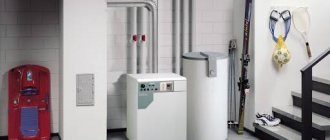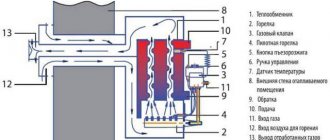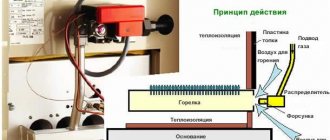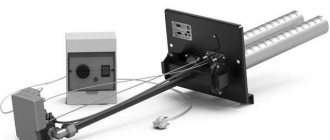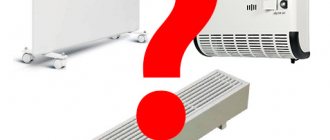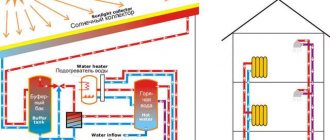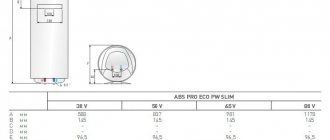There is a misconception that geysers are installed only in old apartments and houses where there is no central hot water supply. Today, a water heater allows you to comfortably survive all seasonal outages (for example, planned pressure tests or repairs of utility networks).
It is necessary to carefully consider the choice of gas equipment - your safety and the health of your loved ones will depend on it. Cheap devices in most cases are made of insufficiently high-quality materials, so if they are not maintained, problems may occur.
In this article we will talk about different types of geysers, study their parameters in detail and give a rating of the best, in our opinion, models in 2022.
Gas or electricity?
Today, there are, in fact, only two types of water heaters for an independent hot water system, which have approximately the same basic cost of 5,000–10,000 rubles: gas and electric. Units with indirect and combined heating are not taken into account, since their use implies dependence of the hot water supply on the heating network. Let us make a reservation that the prices are given for devices of the same brands with similar tank volumes.
The undoubted advantage of electric models is the relative ease of installation
: here we are talking only about connecting the heating element directly, since the hydraulic parts of both types of water heaters do not have any significant differences.
Installation of gas equipment is more complicated and will cost 2–3 times more, but these costs will quickly pay off due to the difference in the cost of electricity and gas. Further operating costs associated with servicing both units are also approximately the same. Based on the above, many experts clearly recommend: if the house has mains gas, then preference should be given to gas water heaters, as they are more economical
.
The generator in non-volatile instantaneous water heaters is designed on the principle of a hydraulic turbine. Water from the water supply constantly flowing through the device acts on the blades, causing the generator rotor to rotate and generate electricity.
Principle of operation
Since the instantaneous boiler operates with high power, reliable wiring is required for connection. The standard connection is made with a three-core cable, where L is phase, N is zero, E is ground.
After turning on the equipment, electricity is supplied to the flow sensor. If the water pressure in the system is sufficient, the sensor closes the contacts. Then the heating element relay is activated and heating starts. Thermal sensors turn on in case of overheating. The circuit is completed by a light bulb on the panel, which lights up while the boiler is operating.
Here is a detailed diagram of the device:
Features of the models
Models of different brands may differ according to several criteria.
Heating element type:
- Open - consists of a plastic case with a spiral inside. When power is applied, the coil heats up and transfers heat to the passing flow.
- Closed - the operating principle is the same, only the spiral is enclosed in a body made of brass or copper. It is more fireproof.
Control:
- Mechanical (hydraulic) type. Adjustable via switch and has 6 power settings. The system consists of a block and a membrane, which, when flowing, moves and pushes the shutdown button. The disadvantage of the mechanics is inaccuracy - it may not work if there is insufficient pressure.
- Electronic type. Contains a microprocessor and sensors. This precise system allows you to maintain the set temperature and also adjust the power to save energy.
Varieties:
- Closed type (pressure). Provides high pressure in pipes to serve multiple intake points. You can use the shower and faucet in the kitchen at the same time. In this case, the water temperature will not decrease.
- Open type (non-pressure). Connect to one fence point. They have a compact body, so they can be installed separately on a faucet or shower.
How it works
The flow-through model differs from a storage boiler in that the design does not have a tank for storing hot water. Cold water is directly supplied to the heating elements and comes out already heated through a mixer or tap.
Let's look at the example of a Termex instantaneous water heater:
As you can see, the electrical circuit of the heater is quite simple. All structural elements can be easily found and purchased if the device fails
Now let's move on to the second, no less important question - let's look at how an instantaneous water heater works
Operating principle
So, using the example of the Termex heater provided above, let’s look at its operating principle.
Connection to the electrical network is carried out with a three-core cable, where L is phase, N is zero, and PE or E is ground. Next, power is supplied to the flow sensor, which is activated and closes the contacts if the water pressure is sufficient for operation. If there is no water or the pressure is very weak, the heating will not turn on, for safety reasons.
In turn, when the flow sensor is triggered, the power control relay is activated, which is responsible for turning on the heating elements. Temperature sensors, which are located further in the electrical circuit, are designed to turn off the heating elements when they overheat.
In this case, the temperature sensor T2 turns on after the heating elements cool down in manual mode. Well, the last element of the design is a neon indicator that displays the process of water heating.
That's the whole operating principle of an instantaneous electric water heater. If the device suddenly fails, use this diagram to find the faulty element.
Other models may have a modified operating scheme, for example, there will be a thermostat, as in the image below.
When cold water is supplied, this membrane moves, thereby pushing the activation lever through a special rod. If the pressure is weak, the displacement will not occur and the heating will not turn on.
Flow or storage?
Instantaneous gas water heaters (also called geysers) have one clear advantage over storage water heaters: compact dimensions, allowing the unit to be installed exactly where it will be convenient to use.
Nevertheless, the requirements for rooms in which any gas equipment is located require good natural or mechanical (forced) ventilation. This is not only due to safety reasons (gas should not accumulate in the room if it leaks), but is also necessary for the normal operation of a gas burner, which requires an influx of a certain amount of air per hour - it depends on the power of the device. For example, a bathroom does not belong to such premises; in most cases it is impossible to place a gas water heater there, despite the obvious convenience of such a solution. We can say that, in fact, an instantaneous water heater is an analogue of a wall-mounted gas boiler, having almost the same design with some amendments made taking into account operation in the hot water system rather than heating.
While losing to instantaneous water heaters in terms of compactness, storage gas water heaters have a number of advantages, which is why most buyers prefer this type of equipment.
The simplicity of the design, comparable only to a samovar, is the key to the low cost of spare parts and maintenance activities for the device. Analyzing the operation of storage and instantaneous water heaters, you can see the following results: - when using a storage tank, there is a significant amount of hot water in reserve, constantly ready for use, while a flow-through device requires some time to ignite the burner, bring the latter to operating mode and warm up heat exchanger walls;
— the temperature of hot water at the outlet of storage devices practically does not depend on water flow, even with a sharp change;
— for instantaneous water heaters, adjusting and stabilizing the water temperature is problematic, since it changes noticeably with fluctuations in flow rate; when hot water is turned on at several points at once, its total quantity is significantly reduced;
— with low water consumption (up to 3 liters per minute), the gas water heater may not turn on, since the dynamic water pressure is not enough to trigger the flow sensor, which gives the command to ignite the burner. Basically, this situation is a consequence of the high operating temperature to which the device is set. Here you have to either change the settings or unnecessarily increase water consumption;
— a storage water heater in no way depends on the input pressure of cold water, while for geysers the minimum value of this parameter is 0.5–2 bar (depending on the specific model), otherwise the unit will not work.
In an instantaneous water heater, during startup, before the heater reaches operating mode, a certain amount of heat is lost, which could be usefully used. Such losses are not typical for storage systems.
The performance of instantaneous water heaters is a rather relative value. When calculating, the temperature difference (ΔT) between cold water at the inlet and hot water at the outlet is taken as 25°C. When the temperature of the water at the entrance to the gas water heater decreases (in reality it can drop to 3-4 ° C), the productivity of the device decreases proportionally - up to 75-80% of the nominal one. To maintain quantity, you can sacrifice quality, that is, use a regulator to reduce the temperature of the hot water at the outlet. Storage units are practically free of this drawback, since their heating element (burner) operates in continuous mode, having enough time to prepare water at a given temperature in the required volume.
Most popular models
The best geyser is a device that is praised not by sellers and the manufacturer, but by consumers. Therefore, before purchasing a gas instantaneous water heater, we strongly recommend reading reviews and paying attention to the most popular models. Let's see which speakers buyers are most often interested in.
Geyser Neva 4511
This column from the Russian company Neva received fairly high user ratings. The device has a capacity of 11 l/min and a power of 21 kW. The column is equipped with an open combustion chamber, an electric ignition system, power-on and heating indicators, and a thermometer. Gas control is also provided. For its operation, the column requires batteries, which power the ignition system. The design of the device is very simple, and the price will please every buyer.
The water heater has received many user reviews, both positive and negative. The number of positive reviews exceeds the number of negative reviews, which is already a big plus. Among the advantages we can include the undoubted simplicity of the model, ease of temperature adjustment and the presence of a thermometer. The downsides are a rather weak heat exchanger and poor performance at low water pressure. But overall, this is a decent device from the budget segment.
Geyser Electrolux GWH 265 ERN Nano Plus
This is one of the best geysers from a renowned manufacturer. Her reviews are mostly positive - we can safely regard her as the optimal choice. Buyers praise the device for its stable operation at low water pressure and ease of settings. Users also note the presence of such a useful option as monitoring the battery status. The appearance of the device is also pleasing - it is immediately clear that this is a completely modern gas instantaneous water heater.
The Electrolux GWH 265 ERN Nano Plus dispenser has a power of 20 kW and a capacity of 10 l/min. It is equipped with an open combustion chamber, a pleasant control panel with an informative display, a thermometer, and numerous security systems. Support of heating temperature at a given level is also implemented. The ignition system is electric, runs on batteries. The minimum inlet pressure is 0.15 atm.
Geyser Bosch WR 10-2P
The best geyser from Bosch according to users. In any case, she is very popular. If we compare it with other models, we can note the efficiency of the device - with a productivity of 10 l/min, its power is 17.4 kW. There is no electric ignition here, but there is a simple piezoelectric ignition. It lights the burner instantly, saving users from loud bangs when the batteries are dead. There is no flame modulation on board, so households will have to periodically adjust the heating temperature.
Reviews about the device are mostly positive - more than 70%. Therefore, it is not surprising that the column has gained such high popularity. It is difficult to identify critical failures, since there are very few of them. Positive features include reliable starting at low water pressure and automatic temperature maintenance.
Device
Instantaneous gas water heaters are structurally similar to wall-mounted heating boilers.
The heating element consists of the main burner, above its torch there is a heat exchanger made of many small diameter tubes through which heated water circulates. Depending on the model, ignition is performed manually by pressing a button or automatically using a built-in piezoelectric element. Automatic control and safety are represented by sensors for monitoring the burner flame, water temperature and chimney draft. In addition, a flow sensor can be installed. The combustion chamber is open; accordingly, atmospheric burners are used here, the air supply to which is carried out due to the vacuum created during the combustion of the gas-air mixture.
Modern geysers are produced, as a rule, in two modifications: with electronic and piezo ignition. The latter are equipped with a pilot burner, which turns on when you press a button on the front panel of the water heater. When water extraction begins, the pilot burner ignites the main burner and the user receives hot water.
Gas water heaters with electronic ignition are started without a pilot flame: the main burner ignites automatically based on a signal from the flow sensor when the tap is opened, which ensures maximum comfort. Such units use either a battery or a built-in generator for power, ensuring complete energy independence of the device.
Special mention should be made of geysers with a modulating burner, which changes its thermal power, providing a constant outlet temperature regardless of pressure and flow. Conventional burners, without a power modulation function, operate according to a simple algorithm: the higher the flow rate, the lower the hot water temperature.
Storage water heaters are somewhat simpler.
Their combustion chamber is closed, which means they can be used both atmospheric - with a natural flow of air through the air intakes, and blown burners, which provide an electric fan for preparing the gas-air mixture. The heat exchanger is the lower wall of the tank, located above the combustion chamber. A special sensor that monitors the water temperature controls the burner, switching active heating modes and maintaining the set temperature. By the way, the thermal insulation of the water tank provides only slight cooling of its contents, that is, the gas consumption to cover heat losses is negligible. The safety automation includes a main burner flame extinction sensor (thermocouple), a water overheating sensor in the tank (triggered when the temperature reaches 90°C), as well as a draft sensor in the air duct and chimney.
Types of geysers
Before considering the characteristics of the device in detail, you need to decide on its type. Water heaters are divided into two types: instantaneous and storage.
Flow-through geysers
Such heaters heat only flowing water, and therefore are small in size due to the lack of a container for storing it. This work is achieved through numerous sensors that control the water supply and its temperature. Therefore, as soon as it heats up to the desired temperature or the tap is turned off, the burner goes out.
Such devices are the cheapest on the market and do not require additional ventilation. But there are a number of disadvantages. Unstable temperature and low power - therefore they are suitable for small apartments, but will not be able to provide hot water to a country house.
Storage water heaters
Gas boilers are equipped with a water tank. As soon as it heats up to the required temperature, the burner turns off. As soon as the temperature drops, it turns on.
Storage heaters use fuel more economically, provide a stable water temperature, and operate even with low gas and water pressure. But if the boiler runs out of water, then you will have to wait a while for the new batch to heat up. In addition, such devices are usually large in size, so for their installation it is necessary to further strengthen the base or install it on a concrete floor.
If we add a high price to these disadvantages, then it becomes clear why such models are not popular: they are usually installed in large country houses.
Service
Maintenance of water heaters is carried out annually, regardless of the type and frequency of use of the unit. At the same time, the correct combustion of gas in the main and ignition burners is checked, and if this process deviates from the norm, the resulting carbon deposits are removed. They also clean the nozzle, nozzle and gas tubes using a soft brush and blowing with air. Burner adjustments may also be required and should be performed by a qualified technician. To do this, you can contact any organization that services gas equipment.
The “sick” spot of an instantaneous water heater is the heat exchanger
, in the descriptions of devices called a heating element. Its tubes are subject to the appearance of scale, which reduces heat transfer, and with it the efficiency of the unit, while the passage of water is also difficult, which increases the hydraulic resistance of the hot water system and, as a result, the load on the pump. To remove deposits, the heating element is dismantled and then washed using special chemical compounds recommended by the manufacturers of specific equipment. The process of scale formation can be significantly slowed down by initially lowering the temperature of the hot water outlet, instead of mixing it with cold water in the mixer. True, this may cause additional inconvenience due to the low performance of the water heater.
The appearance of scale in the heat exchangers of geysers leads to clogging of tubes and subsequent repairs
For storage gas water heaters, the problem of scale formation is not so acute. Due to the large heat exchange surface, which is the entire lower wall of the tank, deposits do not have a significant effect on the process of heating the water. Of course, over time, the storage tanks will also have to be cleaned, but this procedure does not involve dismantling individual components of the device and, most likely, will not require the involvement of a specialist. Again, special chemical compounds are added to the tank: they dissolve the sediment and remove it through the drain hole in the lower part. After this, the container must be rinsed, that is, filled with water once or twice and completely emptied.
After treating the storage water heater tank with chemicals, the device must be thoroughly rinsed by filling it several times and completely draining the water.
Types of boilers
Storage water heaters are either electric or gas . Both types are very similar in operating principle and internal structure. However, some indicators still differ. Let's look at the advantages and disadvantages of a gas boiler over an electric one.
- Higher efficiency. Gas storage devices heat water several times faster than electric ones.
- Gas boilers are slightly cheaper.
- Cheap to operate. Natural gas is an inexpensive fuel, which is not the case with electricity.
Flaws:
- Safety. A gas leak, although unlikely, is, however, an extremely undesirable and dangerous phenomenon.
- The process of installing a gas boiler is much more troublesome and expensive.
Fighting tank corrosion
Just like in electric storage water heaters, an anti-corrosion anode is used to combat corrosion of the inner surface of the tank of gas heaters. The essence of its work is simple: those places where the enamel coating is damaged for some reason - and they are potential sources of corrosion - have a lower electrical resistance compared to the rest of the surface. Consequently, the current flowing from the anode will rush there, preventing rust from forming. Of course, this anode must be monitored from time to time and, if necessary, replaced: all these actions are performed during routine maintenance of the unit. To replace the anode, you must completely drain the water from the tank.
What breakdowns can happen and how to fix them
Troubleshooting should be carried out by qualified personnel. You cannot do repairs yourself, otherwise the device will be void of warranty. The only thing allowed is to replace the batteries in the automatic electric ignition system.
The piezoelectric element or the power cable may fail, but it is not recommended to replace them yourself.
Sometimes the equipment does not work because the ventilation needs to be cleaned, then you should call a technician. This also applies to washing filters and replacing membranes.
Sometimes the water heater does not turn on due to insufficient water pressure. To fix the problem, you need to set the flow control knob to the appropriate position.
Range
Today, storage gas water heaters are significantly inferior in range to their electric counterparts, being represented by only a few manufacturers. Almost all water heaters have modifications for wall and floor mounting, correspondingly varying in overall dimensions and water tank volume - from 50 to 220 liters. At the same time, a two-hundred-liter unit has a thermal power of only 8 kW and, depending on the consumption of hot water, consumes from 0.6 m³ of gas per day.
The choice of instantaneous gas water heaters is much wider - from inexpensive and obviously outdated domestic models to much more modern devices from Korea and European countries. Nevertheless, experts say that geysers should be used only where it is not possible to install a storage unit, and best of all, a full-fledged gas boiler with a built-in hot water boiler.
The column does not ignite initially
Before you climb inside the water heater, you should perform a number of basic steps:
- Replace the batteries and clean the contacts in the power compartment.
- Make sure there is natural chimney draft and normal pressure in the cold water supply system.
- In a turbocharged dispenser powered by mains power, check the fuse. Try switching an imported unit by turning the plug in the socket - some models are sensitive to phase location.
- Clean the dirt filter installed on the cold water supply pipe. Sometimes the mesh at the inlet is provided by the design of the water heater itself.
- After opening the DHW mixer, observe the ignition electrodes - a spark should jump from them. In a turbocharged apparatus with a closed chamber, the clicking of discharges can be clearly heard.
Heater repair begins with cleaning the electrodes and installing working batteries
Did the above measures not produce results? Then remove the column casing and proceed to troubleshooting, following the step-by-step instructions:
- Open the hot water (ask an assistant) and watch the movement of the rod, which should move the pressure plate away from the microswitch button. If the pusher does not move, the reason is 100% inside the water block. You will have to disassemble it, clean it and change the membrane.
- The rod presses on the plate, but the button remains pressed. Probably, the stroke of the pusher has decreased due to scale inside the “frog”, which needs to be opened and cleaned.
- The pusher moves, the button turns off, but there is no sparking. Surely the microswitch is to blame, diagnosed as follows: disconnect its connector and short-circuit the 2 terminals with a screwdriver. If the switch is faulty, then after a direct short circuit a spark will appear on the electrodes.
- The discharge skips on one needle, the second is silent. Pull the high voltage cable out of the electrode housing, trim it slightly and insert it back.
- The “frog” functions, the microswitch is triggered, the electrodes spark, but ignition does not occur. This means that gas is not supplied - the solenoid valve is closed. The culprits of the circuit break are the traction and overheating sensors; to check they need to be closed one by one using a wire. Another option is a break or fracture of the supply wires, which is diagnosed by testing with a multimeter.
You need to short-circuit the connector connected to the pulse unit, and not the microswitch plug
In some models of electronically controlled gas flow columns, a special flow sensor controls the start. It operates on the principle of a limit switch - the water flows, the circuit is closed. Diagnostics is simple: open the DHW valve and test the element contacts with an ohmmeter or a light bulb - it should light up. The algorithm for a complete check of the water heater is demonstrated by the technician in the video:
How to replace the membrane
The procedure for replacing a rubber (or silicone) diaphragm differs little on speakers from different manufacturers. To independently remove and disassemble the water-gas unit, you will need standard tools - open-end wrenches, screwdrivers and pliers. The work order is as follows:
- Turn off the gas and cold water taps on the supply pipelines, remove the casing of the device.
- Disconnect the water supply and fuel supply pipes.
- Unscrew the heat exchanger tube from the “frog” (located on the right), move it to the side or disconnect the interfering wires.
- Unscrew the fastening of the block to the body and remove the assembly.
- Disassemble the membrane unit by unscrewing 4-8 mounting screws. Remove the defective diaphragm and install a spare one, having first cleaned the insides of the camera from scale and dirt.
Installation of a gas water heater
To install a gas water heater, you will need to hire a certified gas specialist. Regardless of the type of unit, it is connected to the gas pipeline and water pipes. The only limitation that may be imposed by the type of combustion chamber used in a given water heater is the installation location. If the chamber is closed, then both the air flow and the removal of combustion products are carried out by electric fans, which greatly simplifies the calculation of the chimney parameters. Usually, a short coaxial pipe that goes out to the street directly through the wall of the house closest to the unit is successfully used. In addition, a closed chamber does not require installing a water heater in a well-ventilated room. Unlike the closed chamber used in most storage water heaters, a chamber with natural draft (open) requires a constant supply of fresh air both for the normal preparation of the gas-air mixture on the burner and to ensure the removal of combustion products. Thus, installing this unit, for example, in a bathroom, is impossible - unless it has a window to the street, which will have to be kept open while the heater is operating, or an air supply unit of sufficient capacity, providing three times complete renewal of the air in the room per hour. Most modern geysers are equipped with such chambers.
The most common breakdowns
Finally, I will give a few of the most common breakdowns of geysers. Most often you can observe the following problems in the operation of heaters:
The coil is clogged with scale. If there is low pressure in the hot water tap, and cleaning the reducer does not solve the problem, it means that the coil is clogged. In this case, it needs to be washed with a remover such as Antiscale;
Antiscale - descaling agent
A depressurized coil can be soldered
- Doesn't light up. There are several reasons why the dispenser may not light up: low water pressure;
- there is no draft in the chimney - perhaps a foreign object has entered the chimney;
- the batteries are dead (applies to speakers with automatic ignition);
- Doesn't heat water well. There may be several reasons: gas equipment is clogged;
- the need to adjust the burner - modern columns have a tap that allows you to adjust the gas supply to the burner.
To increase the service life of the column, install a high-quality filter at the inlet
These are all the most common malfunctions of geysers that you can fix yourself. The service instructions, which usually come with the passport, will help with this.
If you are not sure that you can fix the problem yourself, it is better to seek help from specialists. The repair price starts from 300 rubles excluding the cost of parts.
Performing serious operations, such as soldering a radiator, costs 1000-1200 rubles. Prices are valid for spring 2022.
Tips for choosing a gas device
The purchase of a instantaneous gas water heater should primarily be based on the purposes for which such equipment is installed:
- for continuous or periodic heating of water;
- for large or small volumes of liquid heating;
- for the kitchen or bathroom or for both rooms at the same time.
Having chosen the appropriate device model, you need to familiarize yourself with its parameters that improve the comfort of its use:
- level of maximum water heating temperature, throughput and, most importantly, equipment power;
- display that makes it easier to control the operation of the column;
- availability of several work programs;
- availability of warranty service;
- sensors and protection devices.
It is very important to ask sales consultants about the availability of service centers and the possibility of purchasing spare parts for a specific speaker model.

